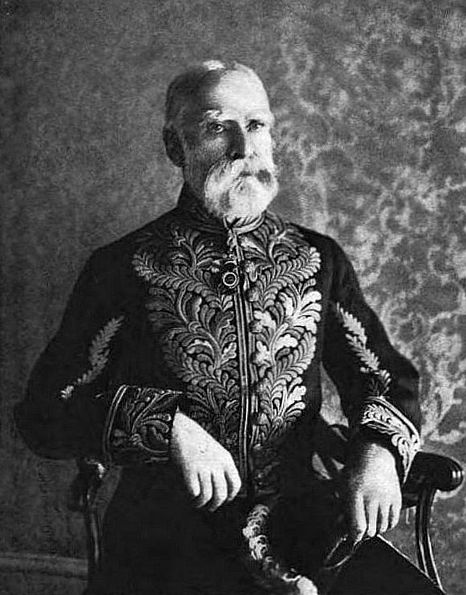THE EARLS OF DALHOUSIE WERE THE GREATEST LANDOWNERS IN THE COUNTY OF ANGUS, WITH 136,602 ACRES
The Ramsay family settled in the Lothians in the 12th century, when they are found witnessing various royal charters to religious houses.
SIMUNDUS DE RAMSAY, who in 1140 witnessed a charter to the monks of Holyrood, and another between 1189 and 1196, is the first of the name on record in Scotland.
WILLIAM DE RAMSAY was witness to the Coldingham Charter, 1198, and to another in 1236.
SIR NESSUS DE RAMSAY (probably cousin) appended his seal to a charter 1250 and 1270.
WILLIAM DE RAMSAY, who was one of the Council of the Magnates of the Realm in 1255, witnessed a charter, 1260, and died 1262, leaving three sons, William, Malcolm, and John.
The eldest son,
WILLIAM DE RAMSAY, was witness to a charter in 1262, and to another, 1274, and died about 1295.
His son,
SIR WILLIAM RAMSAY DE DALWOLSY, or Dalhousie, signed the Ragman Roll at Berwick, 1296.
He appears to have had two sons,
SIR ALEXANDER RAMSAY OF DALHOUSIE;SIR WILLIAM RAMSAY OF INVERLEITH.
The elder son,
SIR ALEXANDER RAMSAY (c1290-1342), of Dalhousie, was warden of the Middle Marches, and, in 1332, Constable of Roxburgh Castle, which he had taken by escalade.
This gallant soldier acquired so high a reputation in his conflicts with the English, that to be of his band was considered as a branch of military education requisite for all young gentleman who ambitioned to excel in arms.
In reward for capturing the fortress of Roxburgh, DAVID II, King of Scotland, bestowed upon Ramsay the office of Sheriff of Teviotdale, William Douglas, Lord of Liddesdale, then held.
From that moment, Douglas, once the friend and companion in arms of Ramsay, became his implacable foe.
In performance of the duty of his office, Ramsay held a court in Hawick church, in 1342, whither Douglas came with an armed retinue and was courteously welcomed by the high-minded and unsuspecting Ramsay; but, regardless of every feeling save that of vengeance, he seized the Sheriff, and dragging him from the judgement seat, had him conveyed to Hermitage Castle, in the dungeon of which he perished by famine.
It is reported, that above the place of Ramsay's confinement there lay a heap of corn, and that with grain which dropped down through crevices in the floor he sustained a miserable existence for seventeen days.
From Alexander we pass to his lineal descendant,
JAMES RAMSAY, who left at his decease, about 1580, two sons, namely,
GEORGE;
John (Sir).
The elder son,
SIR GEORGE RAMSAY, knighted by JAMES VI, King of Scotland, was elevated to the peerage, 1618, in the dignity of Lord Ramsay of Dalhousie, and was succeeded, in 1630, by his eldest son,
WILLIAM, 2nd Lord, who wedded, in 1633, Margaret, daughter of David, Earl of Southesk, by whom he had two sons, George, and John, and one daughter.
His lordship was advanced to an earldom, in 1633, as EARL OF DALHOUSIE, and was succeeded by his eldest son,
GEORGE, 2nd Earl, who died in 1675 and was succeeded by his eldest son,
WILLIAM, 3rd Earl, who wedded Mary, daughter of Henry, Earl of Drogheda, by whom he had three sons and a daughter.
Dying in 1682, he was succeeded by his eldest son,
GEORGE, 4th Earl.
- George Ramsay, 4th Earl (d 1696);
- William Ramsay, 5th Earl (d 1710);
- George Ramsay, Lord Ramsay (d 1739);
- Charles Ramsay, 7th Earl (d 1764);
- George Ramsay, 8th Earl (d 1787);
- George Ramsay, Lord Ramsay (1806-32);
- James Andrew Broun-Ramsay, 10th Earl (1812-60), 1st Marquess.
Marquesses of Dalhousie (1849)
- James Andrew Broun-Ramsay, 1st Marquess of Dalhousie (1812-60).
Earls of Dalhousie (1633; Reverted)
- Fox Maule-Ramsay, 11th Earl (1801-74);
- George Ramsay, 12th Earl (1806-80);
- John William Ramsay, 13th Earl (1847-87);
- Arthur George Maule Ramsay, 14th Earl (1878–1928);
- John Gilbert Ramsay, 15th Earl (1904-50);
- Simon Ramsay, 16th Earl (1914-99);
- James Hubert Ramsay, 17th Earl (b 1948).
The heir apparent is the present holder's son Simon David Ramsay, styled Lord Ramsay (b 1981).
BRECHIN CASTLE, Angus, stands on a massive bluff of rocks above the River Southesk on the site of a much older fortress belonging to the Scottish kings.
The present house was last reconstructed in the early 1700s and incorporates parts of the original Castle dating back to the 13th century.
The building has evolved from a defensive role to its present great house style.
Brechin Castle is steeped in history: In 1296, EDWARD I received the submission of John Balliol, King of Scots, there; and, in 1303, Sir Thomas Maule defended the castle against the English for three weeks until his own death brought about its surrender.
In 1643, Patrick Maule, 1st Earl of Panmure, bought the whole of the Brechin estate from the Earl of Mar.
The Castle was at that time a simple L-shaped house of three storeys.
The 4th Earl of Panmure, married to Lady Margaret, daughter of the 3rd Duke of Hamilton, eventually rebuilt the Castle as it is today.
Former seat ~ Dalhousie Castle, Midlothian.
First published in November, 2013. Dalhousie arms courtesy of European Heraldry.

























